Say no to Barrick Gold in Dominican Republic
Monday, February 29, 2016
Wednesday, October 7, 2015
Compañía canadiense desata un "genocidio silencioso" en República Dominicana
Responsabilizan a una compañía de capital canadiense
de provocar una "alarmante contaminación" de vastas zonas de República
Dominicana con sus actividades mineras utilizando sustancias tóxicas,
que ha afectado a miles de familias pobres.
Las operaciones de la compañía Pueblo Viejo
Dominicana Corporation, filial de las canadienses Barrick Gold y Gold
Corp, están provocando un "genocidio silencioso" contra miles de
familias pobres en la provincia Sánchez Ramírez y otras zonas del país,
dijo a RT el dirigente de la Organización Paz Dominicana, Rafael Guillén Beltré."Las operaciones mineras están provocando una alarmante contaminación debido al uso de cianuro y otras sustancias letales para el ser humano. La flora y la fauna están totalmente afectadas, y todos los residentes que estamos alrededor de la mina respiramos altos contenidos de cianuro", agregó Guillén.
La organización ha llegado a instancias judiciales para solicitar que la compañía paralice sus operaciones, pero hasta el momento no han logrado su objetivo. Guillén denunció además que varios activistas y dirigentes de Paz Dominicana han "sido objeto de amenazas de muerte" por parte de Pueblo Viejo.
La mina Pueblo Viejo es una reserva minera de categoría mundial y uno de los depósitos más grandes de oro no desarrollados. La compañía que opera la mina, utiliza de forma indiscriminada grandes cantidades de agua en sus operaciones, que luego son vertidas en ríos cercanos, generando graves daños al medioambiente.
Monday, November 10, 2014
‘Please tell people about this:’ London students’ horror at Dominican Republic mines
‘Please tell people about this:’ London students’ horror at Dominican Republic mines
Three London students were shocked by what they found last winter during a trip to the Dominican Republic.
Canadian mining companies, they say, are destroying lives in the country.
“We visited the Barrick Gold mine, and while we were there, we spoke
with a woman named Juliana (Rodriguez). She is 82 years old and has
lived in the area for all of her life,” Klaire Gain said. “She told us
the last four years, which (has seen) Barrick Gold mining in the region,
have been the worst years of her life.”
Now, Gain, Claire Morrow and Natasha Jimenez — all recent graduates
of the social justice and peace program at King’s University College —
are working to show the world what they witnessed.
Using their own money, and some brought in through fundraisers, the trio travelled back to the region this summer.
They spent two months living in the area, working on farming co-ops,
meeting and talking with as many residents, along with environmental and
academic experts, as they could. They also hired former CBC cameraman
Mark Visser, and flew him to the region where he filmed more than 100
hours of footage for a documentary expected to be ready by spring 2015.
The mine that’s the focus of their work is located in Pueblo Viejo.
It’s 60 per cent owned by Barrick with the remaining 40 per cent owned
by Goldcorp, another Canadian mining company.
In 2013, the mine produced 488,000 ounces of gold, making it the
largest in Barrick’s operations — and the company says it’s doing good,
not bad, things for the community.
Barrick’s mine was built on the site of an abandoned state-run
operation, and, when the company moved in, waterways were polluted and
causing problems, spokesman Andy Lloyd said.
All waters that have a direct connection to the Barrick site have
since been cleaned up, Lloyd said, noting the company’s involvement has
served as a “catalyst for a huge environmental cleanup of the whole
area” and has pumped money into the economy.
Barrick has also offered King’s students and staff a chance to come
to the mine itself and meet with people working on the effort, he added.
Still, people like Juliana Rodriguez, the woman the students met on
their first trip, aren’t happy. Rodriguez had a clear message she wanted
the group to bring back to Canada.
“She looked at us, with tears in her eyes and said, we are dying
because people in your country want to wear gold rings on their
fingers,” Gain recounted.
She told them: “Please do something, please tell people about this,
please tell your government, because people here are not listening to
us,” Gain said.
The communities in peril “are rural communities, the residents live off the land and their farms were sustainable,” Morrow said.
One man they visited had been farming livestock and growing
pineapples for years. Now, Morrow said, the livestock are dying and he
can’t sell the pineapples because they are grown on contaminated land.
 A mango taken from one of the Dominican Republic farms is used to spell out concerns during a mining protest. (Contributed)
The trio’s expectations for the documentary are realistic.
A mango taken from one of the Dominican Republic farms is used to spell out concerns during a mining protest. (Contributed)
The trio’s expectations for the documentary are realistic.
“We understand that we are not going to make this documentary and all
these companies are going to stop,” Morrow said. “We understand all of
these companies are going to be there for at least another decade. We
understand the hypocrisy of having our computers here.
“What we are passionate about, is, hopefully, (the documentary) will
inspire other people to think about their consumerism and hopefully spur
other economies.”
 A mango taken from one of the Dominican Republic farms is used to spell out concerns during a mining protest. (Contributed)
A mango taken from one of the Dominican Republic farms is used to spell out concerns during a mining protest. (Contributed)Wednesday, June 19, 2013
Barrick Gold pollution
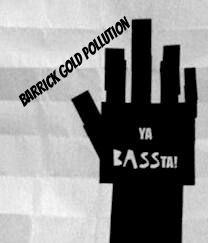 " />
" />On may 16th 2013, the ministry of Public health was doing a study in different communities of Cotui to determine what was the level of contamination made by Barrick gold in the area.
Roberto Berroa, viceministro de Salud Ambiental, al encabezar un encuentro con comunitarios del lugar informó que el objetivo principal levantamiento es atender las afecciones de salud que se presenten a las 600 familias que residen en las comunidades: Los Cacao, El Naranjo, Las Lagunas y la Piñita, provocados por la extracción de oro que realiza la minera.

Berroa sostuvo que al finalizar los análisis que se realizan, al agua de los ríos, a los habitantes, animales y plantaciones agrícolas de esas zonas se rendirá un informe al presidente Danilo Medina, quien determinará las medidas pertinentes de acuerdo a los resultados.
"Salud Publica rendirá un informe al presidente Danilo Medina los daños que pudieran sufririr los ciudadanos en su salud, el medio ambiente, la producción agrícola y ganadera", expresó Berroa.
Los médicos y técnicos que conducen la investigación tomaron muestras de sangre y de agua del rio, en la comunidad del Naranjo, para establecer la cantidad de plomo y otros químicos que pudieran estar causando afecciones respiratorias, en la piel y otros problemas de salud causados por consumo de agua contaminada.
____________________________________________________
This happens one month ago.. and we haven't hear a word from salud publica whatsoever..
Not any plan for Barrick gold to pay what they owe or to build any hospital for the people getting sick, reforest the area, water treatment plans , cleaning the rivers of mercury and cyanide or anything like that..
Barrick Gold should be stopped like they were stopped last month in Chile and Nevada for pollution of the environment..
The question is.. Why they have such an impunity to poison people and destroy the island without any consequences?
New photos..

Pipe use to throw mercury in the maguaca river

Warning tapes where the BG pipes are located

Communities with heavy pollution from Barrick Gold

Barrick Gold working at full speed during holly week

Devastation of the fragile ecosystem by Barrick gold: the destruction of the forest, river, mountains and wild life in the Cibao valley

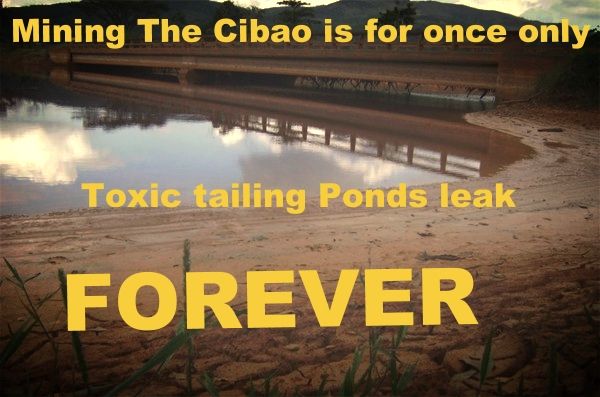
Labels:
Barrick Gold,
cianuro,
contaminacion,
contaminated rivers,
contamination,
Cotui,
cyanide,
dile no a la Barrick,
Dominican Republic,
law,
mine,
pollution,
Republica Dominicana,
Santo Domingo,
scam,
smuggling
Thursday, June 13, 2013
The incongruity of Barrick Gold
RE: Say no to Barrick Gold pirates
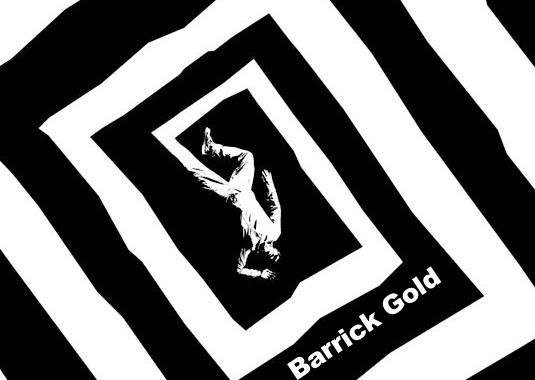 " />
" />There are big problems in the island of Santo Domingo, where Haiti and DR share the island.Each with a population of about 10 million, the Dominican Republic and Haiti are vastly different. The Dominican Republic, occupying the eastern two-thirds of the island of Hispaniola, is wealthier and more stable. It has a free trade agreement with the U.S. and Central America and is a top tourism destination in the Caribbean.
Metals mining can generate environmental problems in even developed, stable countries because of the industry's reliance on hazardous materials, said Payal Sampat, international program director for Earthworks, a U.S.-based watchdog organization.
"Even in the United States, metals mining is a sliver of the gross economic output of the country and it's still the number one toxic polluting industry," Sampat said. "So that's food for thought for countries like the Dominican Republic and Haiti that are on the cusp of embracing large-scale mining without all the regulations and historical experience."
The Dominican Republic lacks strong environmental regulations, a major reason the state-owned mining company could cause such destruction and why there was no real effort to clean up the mess, said Virginia Rodriguez, a coordinator for SalvaTierra, a local nongovernmental organization whose name translates as "Save the Earth."
Rodriguez said Barrick's plans to use 24 tons per day of cyanide in the mountainous center of the Dominican Republic, source of some of the country's most important rivers, makes her nervous. "There is a very high risk especially with an island like ours with a very fragile ecosystem," she said.
Supporters of the project note say Pueblo Viejo will be a huge economic boon for the Dominican Republic. The nearly $4 billion direct foreign investment is by far the largest in the Caribbean nation's history. Barrick on papers will be the Dominican Republic's largest exporter and add 2 percent to the nation's GDP.
But so far the government haven't seen nothing, zero nada.
The mine itself will only produce about 2,000 jobs but the company says about 11,000 workers were involved in the construction and there will be more than 10,000 jobs indirectly created by the project, company and government officials say.but somehow those jobs were related to a peruvian crew.No jobs for dominicans whatsoever.
"This is a major industrial achievement for the country," said Dominican Mining Director Octavio Lopez. "Imagine what this will do for our economy aside from the exploitation of the gold, with some 10,000 jobs, 83 percent of them for Dominicans."
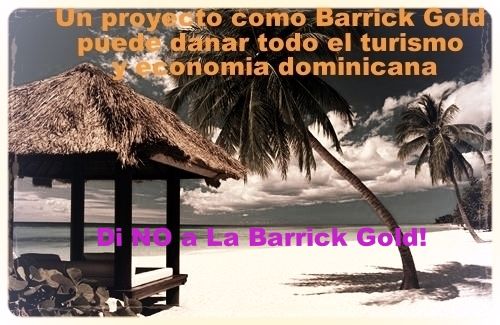
In papers, If gold prices hold up, mining eventually will surpass tourism as the country's largest income earner, with royalties and other revenue making up about 5 percent of the government's budget.But BG havent pay nothing to the Dominican government, and it doesn't look like they are ready to do so.
But skeptics are uneasy about the cyanide used to process the ore and question whether the operators can guarantee their assurances to contain chemical runoff in a country prone to major flooding, especially during hurricanes.
"We are not against mining in the Dominican Republic necessarily, but the industry has been its own worst enemy here," said Luis Carvajal, a biologist at the University of Santo Domingo and a prominent critic. "Without a doubt, the impact of the mine will be significant."
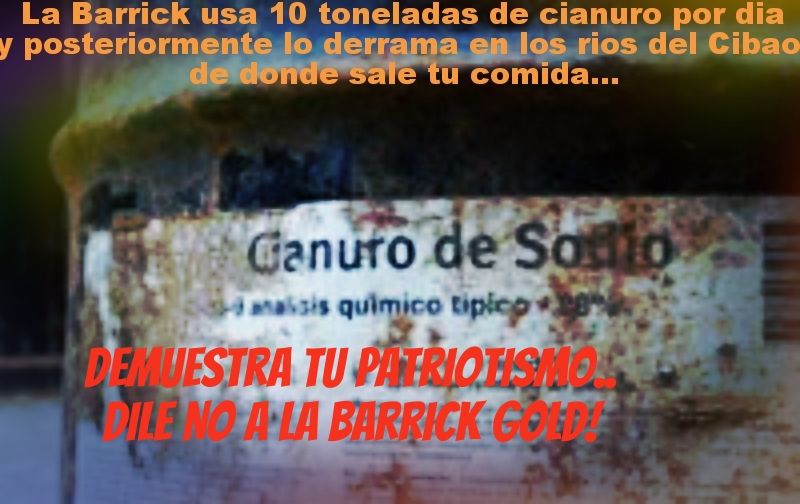 " />
" />So far the pollution in DR caused by BG in the Maguaca and Chacuey river and Hatillo dam is overwhelming.Sooner or later , that damage is going to be paid with wild life and human lives as well.
Not to mention the crops and cattle.
They haven't plant a single tree and in the last agreement with government officials , they didn't talk about reforestation, paying fines, water treatment facilities, hospital for people already getting sick, etc, etc..
Barrick Gold have a long reputation of pollution and contamination all over the world,They were recently fined at Chile and Nevada USA. It's practically impossible to work without tons of cyanide.
Chile could do it..Nevada could do it. Time to stop the Barrick for the benefit of the poor people and the next generations.
Labels:
Barrick Gold,
cianuro,
claims,
contaminacion,
contaminated rivers,
contamination,
Cotui,
cyanide,
dam,
dusting,
history of barrick gold,
led,
mine,
mineria,
presa,
reforestation,
Republica Dominicana
Monday, June 10, 2013
La contaminacion de la Barrick
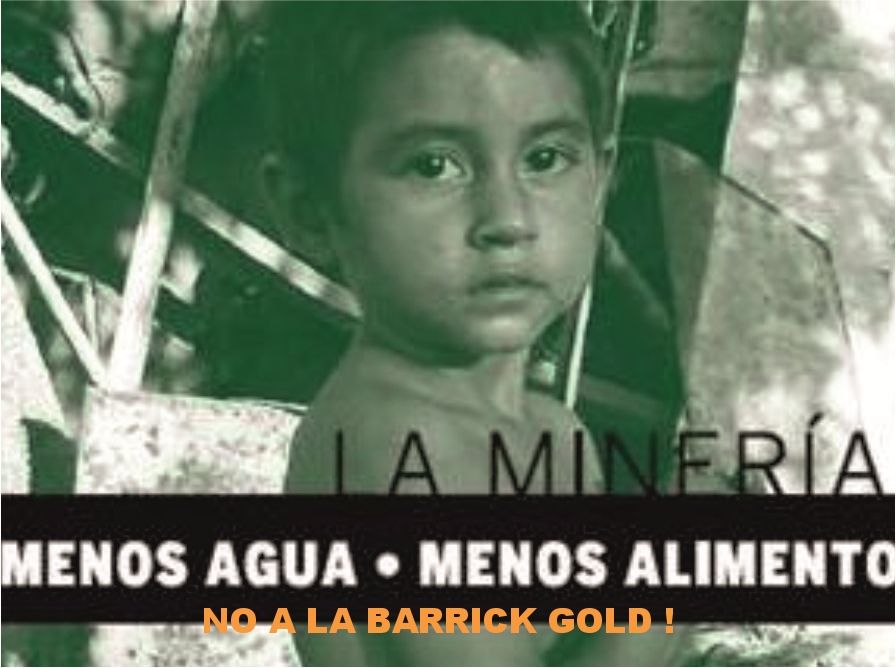
SDE.-"La República Dominicana enfrenta un doble peligro con la explotación de los sulfuros de la mina de PuebloViejo, Cotuí, que lleva a cabo la Barrick Gold", afirmó ayer ingeniero Químico Rafael Solano Liz, quien narró las ocasiones en que esta transnacional canadiense ha sido multada en Estados Unidos y Chile por daños al medio ambiente.
Dijo el ingeniero Solano Liz, que el país está expuesto a que sus riquezas de oro, plata, cobre y otros metales que se encuentran en la mina de Pueblo Viejo, Cotuí, sean saqueados por la Barrick Gold, que logró agenciarse un contrato altamente lesivo a los intereses nacionales.
A juicio del experto el país y, específicamente la provincia Sánchez Ramírez y zonas aledañas, están expuestas a las graves consecuencias de una severa contaminación ambiental, por el ejercicio irresponsable de la transnacional Barrick Gold, en materia de explotación minera.
Recordó que recientemente, la Barrick Gold fue multada en Los Estados Unidos y Chile, por agresión al medio ambiente, lanzando durante varios años consecutivos, en forma clandestina, químicos tóxicos al medio ambiente, axial como por no proteger una amplia zona de glaciares en Chile, donde la transnacional minera explota yacimientos minerales.
De acuerdo al ingeniero Rafael Solano Liz, en Reno, Nevada, Estados Unidos, la Barrick Gold ocultó que contaminó con mercurio, cianuro y plomo.
Y asimismo, de igual manera, a un mes de que la dirección de Aguas de la Región de Atacama, en Chile, solicitara que Barrick Gold Mines Corporación sea multada por incumplir con la protección de los glaciares situados dentro del proyecto binacional chileno-argentino Pascua Lama, la minera acaba de ser multada en Reno, EEUU, recientemente, por la liberación de sustancias químicas tóxicas.
La Agencia de Protección Ambiental de EEUU ha ordenado a tres minas de oro del norte de Nevada a pagar un total de 618 mil dólares por no informar la liberación de químicos tóxicos, incluyendo cianuro, plomo y mercurio desde 2005 hasta 2008.
Dijo que si la Barrick Gold ha sido capaz de llevar a cabo esta práctica en países que cuentan con sólidas instituciones que velan por la protección del medio ambiente, como es en caso de Los Estado Unidos y Chile, en este país será peor.
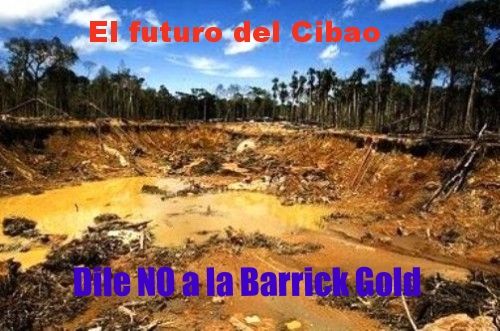
Lamentó que el Ministerio del Medio Ambiente dominicano este en pañales y que esto obligue a prepararse para estar vigilantes ante los crímenes medioambientales en que pueda incurrir la Barrick Gold en la provincia Sánchez Ramírez y zonas cercanas.
En el ultimo contrato, el acuerdo no menciono absolutamente nada acerca de contaminacion, desalojos y plantas de tratamientos de aguas..La Barrick Gold tampoco ha pagado nada todavia a las autoridades dominicanas..
Sunday, June 9, 2013
Barrick Gold’s Perfect Storm Peter Munk on Resource Nationalism and the Changing Global Paradigm
The origin of problems according to Barrick Gold
Barrick Gold’s Perfect Storm Peter Munk on Resource Nationalism and the Changing Global Paradigm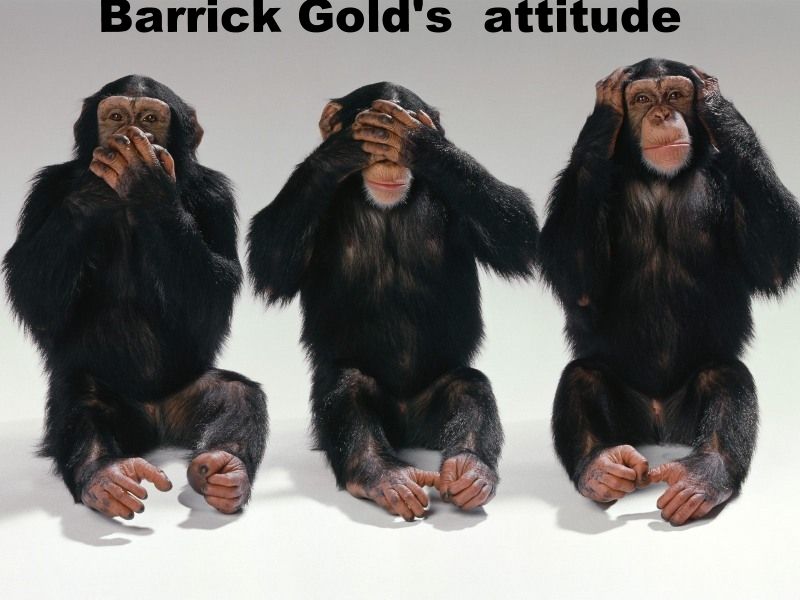
“Please understand” … pleaded Peter Munk several times to shareholdersgathered in Toronto on April 24th for Barrick’s annual shareholdermeeting (AGM) as he laid out the reasons why Barrick Gold has lost nearly three-fourths of its company value, why projects are being closed due toenvironmental contamination, and why all of a sudden gold, and Barrick Gold stock in particular, doesn’t look so attractive. The speech is a revelation of what really drives the gold miningindustry and one of the most controversial industry leaders in particular.
Munk was clearly referring to Pascua Lama, the multi-billion dollar goldproject on the Argentine-Chilean border that has become a constant headache forBarrick Gold. The project is riddled with environmental problems and unpredictedand escalating costs, and suffered as a result of the collapse of the financingscheme Barrick hoped to build with subsidized public money from EDC (Canada)and EXIM bank (USA). Today, the mine remains closed in Chile for failure tocomply with environmental regulations. Barrick’s legal appeals have had noinfluence on the Chilean authorities.
A year ago today, Munk boasted that the fundamentals were brilliant.Barrick was on the verge of launching two of the most spectacularly unique goldmines, Pascua Lama in Argentina/Chile and Pueblo Viejo in the DominicanRepublic. Both projects would be characterized by exceptional production, longlife, and some of the lowest average operating costs per ounce. This yearthough, Munk was reduced to asking, “What can I say to you? ...The fundamental stoday could not be more different than they were a mere twelve months ago. Our two mines are both in trouble”. (AGM Speech: Minutes 43:00-44:00)
At both Pascua Lama and Pueblo Viejo, Barrick has run into significant problems.Munk attributed this to growing resource nationalism, which he referred to numerous times throughout his speech. He says it’s a global phenomenon and the underlying characteristic of the new mining paradigm.
He posed the following hypothetical situation to the audience: “You’rethe new president of a small Latin American country… You have two choices, keepon taxing the people… or go after that big multinational huge globalcorporation with billions of dollars of assets. … This is totally understandable, it is the essence of this enormously rapidly growing resource nationalism… It is the ultimate threat to the very lifeline of the mining industry, which ultimately will cause an enormous spike in commodity prices. (Minutes46:00 - 47:00)
He pointedto leaders such as Hugo Chavez of Venezuela and Evo Morales of Bolivia … suggesting that “there’s a whole slew of new modern populist leaders that may not follow the rule of law as we expect them to do”. (Minute 48:00)
While never explicitly stated, it was clear that his critiques were no tso much about Chavez and Morales, but rather referred to his frustration with Argentina and Dominican republic
Ironically, the venting and frustration over host government rule-bendingquickly vanished when Munk came to the issue of executive pay. There, Munk pointed to the impressive CV of newCo-Chairman John Thorton, former Goldman Sachs chief, as a justification for awhopping US$11.9 million pay package from the gold giant to have Thorton takeover Barrick, which has dropped in value by nearly 75% since its recent marketpeak.
In his closing comments, Peter Munk reached out to the essence of whatsustains the gold industry. Companies mine, process and sell gold not forsocial or economic development, not for social progress and not for the benefitof the needy or the poor communities in the countries where Barrick Gold isinvested
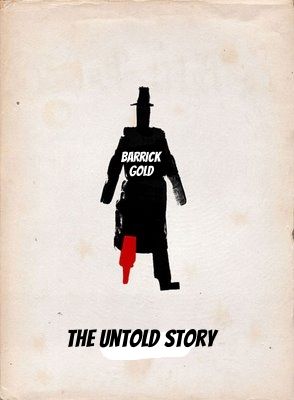
So, the conclusion of BG speech:
- Dominican president is as radical and keep the same political lines of as Chavez and Morales
- The most important mines of BG are Pascua lama and Pueblo viejo have a populist leader that "dont follow the rules of law"
- BG always follow the rules of law
- BG is not in DR for social progress or the needy poor communities of Cotui.
- BG never mention pollution, smuggling cyanide, fines, etc so all those "rumors" are probably a lie
- Barrick Gold has lost nearly three-fourths of its company value, shareholders are VERY scare
- It's ok to pay somebody a bonus of $11.9 millions made from dominican gold , but not a single dime yet to dominican people
source: www.gowebcasting.com/events/barrick/2013/04/24/2013-annual-meeting-of-shareholders/play/stream/7102
These are the personal words of BG president Peter Munk in the last shareholder meeting..
Personally I am speechless ..
You make your own conclusions..
Labels:
Barrick,
Barrick Gold,
claims,
contaminacion,
Cotui,
customs,
cyanide,
dile no a la Barrick,
Dominican Republic,
law,
mine,
mineria,
mines,
Peter Munk,
reforestation,
Santo Domingo,
say no to Barrick gold,
scam
Subscribe to:
Posts (Atom)


